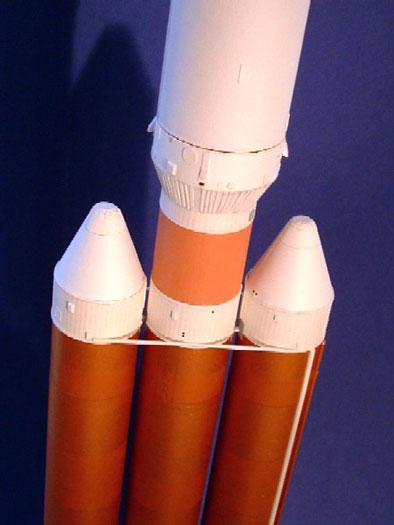|

HyperScale is proudly supported by
Squadron.com
It may be hard to believe, but this rocket can trace its origins back
to the mid-1940s when the U.S. government was trying to develop a
ballistic missile. That effort resulted in the Atlas, and the Atlas V is
the latest generation of that vehicle. The Atlas V family is based on
the 12.5-foot diameter Common Core Booster (CCB), which is powered by a
single two-chamber RD-180 engine. It also carries a stretched Centaur
upper stage.
When you combine a single CCB with a standard Atlas payload fairing, you
get at Atlas V 400 series. When you combine a CCB with a larger payload
fairing (the same one developed for use on the Ariane 5) and add some
solid rocket boosters, you've got at Atlas V 500 series.

Then there is the monster of the family, the Atlas V HLF, or "Heavy." It
consists of three CCBs and carries the larger payload fairing. It is
part of the U.S.'s Evolved Expendable Launch Vehicle (EELV) program, and
will be a competitor of -- or compliment to, depending on your optimism
-- to the Delta IV Heavy. While the Delta IV Heavy has had its first
launch, the Atlas V HLV has not yet flown.
 Nobody
offers a card model of the rocket, so I decided to scratchbuild one. I
scoured the Internet for references, and found some decent photos of
400- and 500-series Atlas Vs, and some drawings of the Atlas V HLV. Some
of the drawings are contradictory in their details, however, so I will
admit up-front that some of the model employs "creative gizmology," in
Shep Paine's words. Nobody
offers a card model of the rocket, so I decided to scratchbuild one. I
scoured the Internet for references, and found some decent photos of
400- and 500-series Atlas Vs, and some drawings of the Atlas V HLV. Some
of the drawings are contradictory in their details, however, so I will
admit up-front that some of the model employs "creative gizmology," in
Shep Paine's words.
In particular, I couldn't find any decent references detailing the
attachment fittings that connect the three CCBs together, so I cooked up
something akin to the fittings between the shuttle's ET and SRBs. Also,
some drawings I came across showed the two strap-on CCBs with white
interstage adapters between the CCBs and their nosecones, while other
drawings omitted them. I added them, but I may change that later.
Lastly, I've seen some drawings with the Centaur sporting the
orangey-red insulation (the route I went) and other drawings with the
Centaur done in white, with corporate logos and an American flag.
Each CCB is an appropriately-sized model rocket tube, covered with a
copper paper that I found at an art supply store. To simulate the
different bands and sections, I taped off horizontal sections of the
paper and "scoured" alternating bands with a ScotchBrite pad to give it
a bit different hue and sheen. The paper was then cut to the proper size
and the "skin" was applied to the cardboard tube. I used an online
shroud calculator to determine the dimensions of the aft transition
structure and heat shield, as well as the nosecones on the two strap-on
CCBs. All propellant feedlines, avionics pods and other bits and pieces
are card or paper.
The payload fairing was also built around a model rocket tube, and I
used 65-pound paper for most of the construction. For the nosecone and
boattail parts, I borrowed the similar parts from one of Erik te Groen's
Delta II payload fairing noses and boattails, figured out how much
larger they needed to be (in this case, 124 percent) enlarged it on a
photocopier and then cut out the pieces.
Click the thumbnails below to view larger images:
Model, Images and Text Copyright © 2005
by David Hanners
Page Created 02 March, 2005
Last Updated
02 March, 2005
Back to
HyperScale Main Page |
Home
| What's New |
Features |
Gallery |
Reviews |
Reference |
Forum |
Search